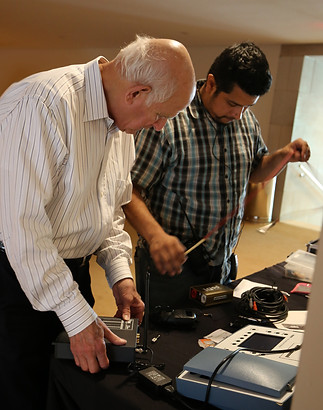MEYERSON SYMPHONY CENTER
What is it like to attend a symphony with a hearing impairment? Would you miss the rich, sonorous notes of the cello? Would the brassy, brilliant trombone be lost?
About 20 percent of Americans report some degree of hearing loss, and—for people over 65—that percentage increases to 33%.
With so many people experiencing mild to profound hearing loss, how does a concert hall make music accessible to everyone?
A mission for everyone
The Dallas Symphony Orchestra's mission is to entertain, inspire, and change lives through musical excellence. This objective is designed to connect with the broadest possible audience.
In fulfilling its commitment to the community, the orchestra annually reaches more than 230,000 adults and children through performances, educational programs, and community outreach initiatives. Still, connecting with everyone starts at home with the Morton H. Meyerson Symphony Center.
The Meyerson, owned and operated by the City of Dallas, regularly served its audiences by offering an infrared assistive listening system. Still, as the units aged, replacement options were needed.
"We want to offer a reliable, user-friendly assistive hearing solution to enhance the live music listening experience," shares Lamar Livingston, Technical Director at the Meyerson Symphony Center in Dallas.
Assistive listening systems are always intended to boost sound, but in the case of the Meyerson, the quality of the sound—as perceived by a typical user—mattered.
"Our main goal is to maintain the best sound quality for classical music, but we also have to ensure there is clarity and intelligibility for various events, including amplified concerts and corporate meetings," says Livingston.
Next-generation assistive listening
“We were already exploring this idea of a new assistive listening system when, out of the blue, Barry Epstein of Dallas Summer Musicals had a conversation with the Dallas Symphony about a solution successfully implemented at Music Hall Fair Park. He asked if the venue would like to test this new approach,” Livingston adds.
Livingston and Meyerson’s Audio Electronic Technician, Ursula Castillo, went to a show at Fair Park to try out the Hear Us Now® system. “We were knocked out with the sound. There was full spectrum EQ [equalization]. It was very clear. If I were paying for a ticket for that show, I would want this product. It provided every detail and nuance of what was happening onstage.”
The Hear Us Now system isn’t just a product. It’s an approach to assistive listening that produces a richer experience for the audience members who use it, including operator training and ongoing quality control.
It uses a standard RF [radio frequency] transmission assistive listening system. Still, it leverages custom-manufactured headphones and additional processing to give signal depth and clarity beyond what is ordinarily available in hearing assist technology.



Design in context
“Ursula and I began selecting equipment. We knew we wanted Listen Technologies for the RF transmission, so before we made the final purchase, we tested different antennas with this system,” highlights Livingston.
Finding the right location for the antenna took some trial and error so that it wouldn’t be visible or in the way of any moving rigging. Castillo came up with the idea of putting it in the followspot [spotlight] booth. The result was good coverage in all the seating areas. Once Castillo had everything installed, it was time for the processing.
Ryan Knox of Idibri, who is working with Epstein to develop the Hear Us Now system, created the detailed processing for the assistive listening signal. Knox did the programming on a day when DSO had two rehearsals, which allowed them to work with the live sound to make adjustments in the software.
Assistive listening for a venue as sophisticated as the Meyerson is more complex. The venue has variable acoustics, including a canopy that raises and lowers, as well as various concerts and corporate events. The system can’t be set on autopilot. Instead, a separate mix is kept fresh for every performance type to ensure clarity and intelligibility—just like for the systems in the main room.

Testing with students and experts
The Callier Center at the University of Texas at Dallas brought graduate audiology students—some with cochlear implants, others who rely on hearing aids, and others who use no devices—to experience the systems during a DSO rehearsal. Carol Cokely, PhD, CCC/A, Clinical Associate Professor and Coordinator of Clinical Teaching, and Professor Linda Thibodeau, PhD, CCC/A, asked students to test the Hear Us Now system to give feedback on the experience for Livingston, Castillo, and Epstein.
"We were glad to have listeners who experience hearing impairments test-drive the system in a format where they could give us immediate feedback," says Livingston. "We were excited to hear that they liked the sound quality and felt like it replicated the same experience people without hearing impairments are having, and we're ecstatic to pass the test with that group."
One student mentioned that she would recommend the system to patients she was working with because it was easy to use.
"The system was good before Hear Us Now," offers Livingston, "but this punched it up another level. The sound image is clear, and the signal-to-noise ratio is improved. It is more consistent. We're delivering all of the sounds that are produced onstage. "

